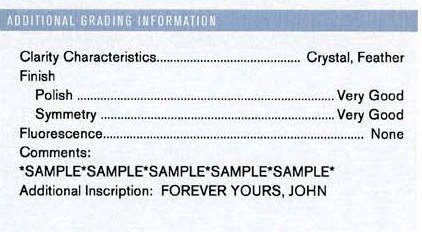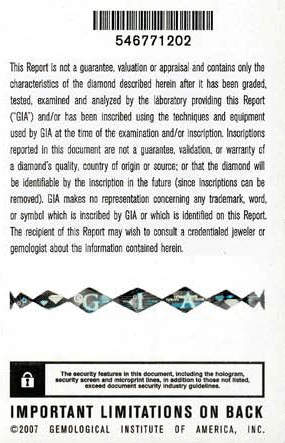Part 2
Back to Part 1
3) Laser Inscription Registry

Diamond grading reports from the GIA carry a 'Laser Inscription Registry' this is the abbreviation GIA followed by thereport no. The micro laser inscription is made on the girdle of the diamond.
4) Shape and Cutting Style

Shape refers to the physical shape and outline of the diamond. examples of shape include Round, Pear, Oval and Heart.
The cutting style refers to the arrangement of the facets in a diamond. Examples of cutting styles include Marquise, Emerald, Brilliant, Princess, Mixed and Step Cut.
5) Measurements of the diamond

This refers to the measurement of a diamond given in the following format:
i) Round Diamonds: " minimum diameter - maximum diameter x depth "
ii) Other shapes of diamonds: "length x width x depth"
The weight of a diamondis measured with an accuracy of 100th of a millimeter using a micrometer or special non contact devices.
Grading Results (GIA's 4C's)

This forms the second block of a GIA report. It will be discussed below from the numbers 6 to 9.
6) Carat Weight
This is the carat weight of the diamond.
Although diamonds are weighed with an accuracy of one thousand of a carat using a digital measuring device, it is rounded to a hundreth of a carat on a grading report.
For more information on Carat weight of a diamond, please see my article on carat weight.
7) Color Grade
This is the color grade of the diamond. It ranges from D to Z for non-fancy colors.
The color grade of a diamond is determined using a master set of diamonds. For more information on color grade of a diamond, please see my article on color grade.

GIA Color Scale diamonds
8) Clarity Grade
The best clarity grade is Flawless (F). It ranges from F to I3.
The clarity of a diamond refers to tha nature of inclusions such as the number, placement and size. It also includes the surface irregularities of the diamond.
The clarity should always be based on what is visible on a X10 loupe. Stereo microscopes are also used by experienced diamond graders.
For more information on clarity of a diamond, please see my article on clarity grading.

GIA Clarity Scale
9) Cut grade
The cut grade of a diamond
This is probably the most important of the 4C's of a diamond. Cut can be graded as Ideal, Premium, Very Good, Good, Fair and Poor.

GIA cut grading of a diamond
For more information on cut of a diamond, please refer to my article on the Cut of a diamond.
Additional Grading Information

10) Finish, Polish and Symmetry
Polish refers to the quality of the polishing of the facets of the diamond. Special care has to be taken by the diamond cutter in order to produce an excellent polish. Polish can be graded into Excellent, Very Good, Good, Fair and Poor.
Symmetry refers to the alingment of facets to one another. This can easily be detected by using a loupe.
11) Fluorescence
This refers to the appearance of a diamond under long wave ultraviolet radiation. Fluorescence can be graded into None, Very Faint, Faint, Faint Blue, Medium Blue, Strong Blue, Very Strong Blue, Faint Yellow, Medium Yellow, Strong Yellow and Very Strong Yellow.
12) Comments
This is for discussing briefly some characteristics/properties that are not discussed in other sections of the report.
13) Additional Inscription
This is the personal message inscribed on the girdle of the diamond using laser. eg "FOREVER YOURS, JOHN" or your logo.
14) Plot of a diamond

This refers to the graphical representation of the inclusions and other imperfections of the diamond. The inperfections of each diamond is unique-just like a fingerprint. It can be used to easily identify the diamond. The internal characteristics are plotted in red while the external characteristics are plotted in green.
15) Key to symbols

This key refers to the characteristics marked in the plot.
16) Proportional Graphic Representation

This is the proportional graphic representation of the diamond found in GIA reports. The proportion of the diamond, the thickness of the girdle and features of the culet are all represented in this diagram. However in older reports you may not find this graphic representation.
i) The depth percent refers to the percentage of the depth of the diamond (Table to culet), relative to the width of the stone.
ii) The table percent is the size of the table as a percentage of the width of the diamond.
the above ratios/percentages are very important as it helps determine how well a diamond has been cut.
iii) The culet of the diamond refers to the facet at the bottom of the diamond (at the pointed part). If present it helps prevent chipping of the diamond. Culet sizes could be none, very small, small, medium, slightly large, large, very large and extremely large.
iv) The girdle is the dividing line between the upper part of the diamond (Crown) and the lower part (Pavillion). Custom messages are usually inscribed on the girdle using laser.
The girdle may be Not Faceted, Faceted or PartiallyFaceted.
The thickness of the girdle may be Extremely Thin,Very Thin,Thin, Medium, Slightly Thick, Thick, Very Thick and Extremely Thick.
17) Security features

Security features on a GIA diamond report
Several security features makes it really hard to forge a grading report. The security feature includes a hologram and upc codes.
Back to Part 1
You are welcome to discuss this post/related topics with Dr Shihaan and other experts from around the world in our FORUMS (forums.internetstones.com)
Our Twitter Updates
